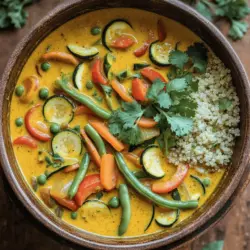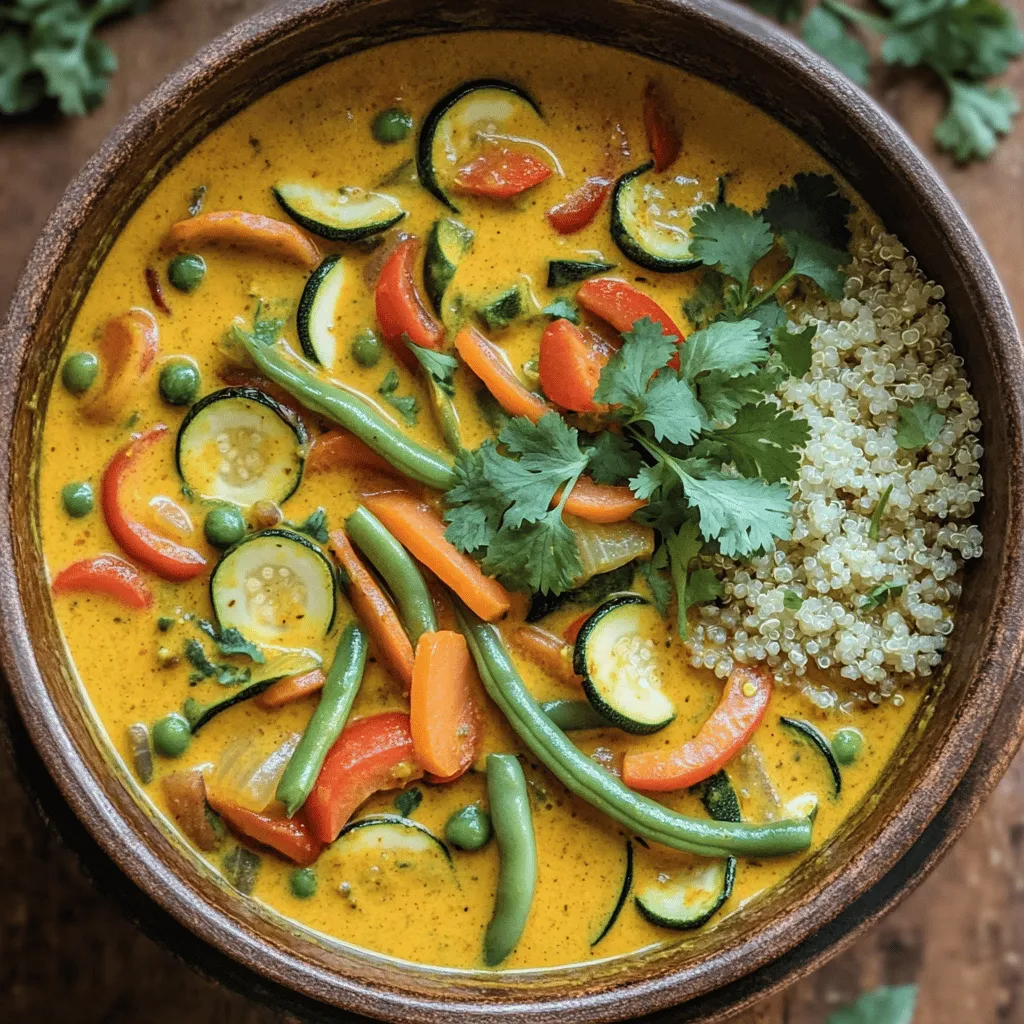Looking for a quick and tasty meal? My Easy Vegetable Curry is both flavorful and packed with nutrients. With simple ingredients like coconut milk, chickpeas, and fresh veggies, you’ll have a warm dish ready in no time. Whether you’re cooking for one or a family, this recipe delivers comfort and nutrition. Ready to make your kitchen smell amazing? Let’s get started with the ingredients!
Ingredients
List of Ingredients
- 1 tablespoon coconut oil
- 1 medium onion, diced
- 3 cloves garlic, minced
- 1 tablespoon ginger, grated
- 1 carrot, sliced
- 1 red bell pepper, chopped
- 1 zucchini, diced
- 1 cup green beans, trimmed and cut into 1-inch pieces
- 1 can (14 oz) chickpeas, drained and rinsed
- 1 can (14 oz) coconut milk
- 1 cup vegetable broth
- 2 tablespoons curry powder
- 1 teaspoon turmeric
- Salt and pepper to taste
- Fresh cilantro, for garnish
- Cooked rice or quinoa, for serving (optional)
Gather these simple ingredients to make a tasty vegetable curry. Each item plays a key role in building flavor. Coconut oil gives a rich taste, while onion, garlic, and ginger add depth. Fresh veggies like carrot, bell pepper, zucchini, and green beans provide color and nutrition.
Chickpeas are a great source of protein. Coconut milk makes the curry creamy, and vegetable broth adds moisture. Spices like curry powder and turmeric bring warmth and warmth to the dish.
You can serve this curry over rice or quinoa for a fulfilling meal. The fresh cilantro on top adds a delightful touch.
Step-by-Step Instructions
Preparation Steps
1. Heating the coconut oil
Start by heating the coconut oil in a large pot over medium heat. This oil adds a rich flavor and helps the veggies cook evenly.
2. Sautéing the onion, garlic, and ginger
Once the oil is hot, add the diced onion. Sauté for 3-4 minutes until it becomes soft and translucent. Next, stir in the minced garlic and grated ginger. Cook these for about a minute until they smell great.
3. Adding vegetables and chickpeas
Now it’s time to add the sliced carrot. Sauté it for about 5 minutes until it starts to soften. After that, mix in the chopped red bell pepper, diced zucchini, and green beans. Cook all these for another 5 minutes, stirring often. Finally, add the drained chickpeas for extra protein.
Cooking Steps
1. Mixing in coconut milk and broth
Next, stir in the coconut milk and vegetable broth. This is where the curry gets its creamy texture. Add the curry powder and turmeric for flavor, and mix well.
2. Simmering the curry
Bring the mixture to a boil. Then, reduce the heat to low and let it simmer for 15-20 minutes. This allows all the flavors to blend together nicely.
3. Final seasoning before serving
After simmering, taste the curry. Add salt and pepper as needed. Serve the curry hot, garnished with fresh cilantro. You can also serve it over cooked rice or quinoa if you like.Enjoy your delicious and easy vegetable curry!
Tips & Tricks
Perfecting Flavor
To create a rich flavor in your vegetable curry, balance the spices well. Start with curry powder and turmeric for warmth. Adjust the amount based on your taste. If you want more heat, add cayenne pepper or chili flakes.
For the right consistency, ensure you simmer the curry long enough. This helps the sauce thicken and blend the flavors. If it’s too thick, just add a splash of vegetable broth or coconut milk.
Using fresh herbs can really lift your dish. Fresh cilantro adds a bright finish. If fresh herbs aren’t available, dried ones work too, but use less. Dried herbs are stronger, so start with half the amount.
Time-Saving Tips
To make cooking faster, prep your ingredients ahead of time. Chop your veggies and measure spices before you start cooking. This cuts down on cooking time and keeps you organized.
Use quick cooking techniques, like sautéing. This method softens veggies fast and builds flavor. Stir-frying is also effective for quick meals.
Having the right kitchen tools can speed things up. A sharp knife makes chopping easy. A large pot helps you cook everything in one place. Consider a wooden spoon for stirring and a ladle for serving. These tools make your cooking experience smoother.Enjoy your cooking!

Variations
Ingredient Substitutions
You can switch up the veggies in this curry for a new taste. Try using sweet potatoes or spinach. Both add great flavor and nutrients. You can also use whatever you have available in your kitchen.
For a protein boost, think about using tofu or tempeh. These options soak up flavor well. They also make your meal heartier.
If you want to reduce fat, use low-fat coconut milk. It gives you the same creamy texture with fewer calories. This way, you can enjoy a lighter dish without losing taste.
Flavor Enhancements
To kick up the heat, try adding chili powder or cayenne pepper. These spices add a nice kick to the dish. Just a little goes a long way!
You can also add fresh herbs like basil or mint. These herbs brighten up the curry and add freshness. They make your meal feel even more special.
Lastly, experiment with sauces. A splash of soy sauce or lime juice can change the flavor profile. These additions can make your curry even more exciting and flavorful.
Storage Info
Best Practices for Storage
To store leftovers, let the curry cool first. Use an airtight container. This keeps the flavors fresh. You can store it in the fridge for up to five days. If you want to save it longer, consider freezing. Use freezer-safe containers or bags. Leave some space for the curry to expand. It can last up to three months in the freezer.
For reheating, simply thaw the curry overnight in the fridge. Heat it in a pot over low heat. Stir occasionally to warm it evenly. You can also use a microwave. Heat in short intervals, stirring in between. This helps avoid hot spots.
Shelf Life
In the fridge, your vegetable curry lasts about five days. If you notice an off smell or strange color, it’s best to toss it. Always trust your senses when checking freshness. If it looks good and smells fine, it should be safe to eat.
FAQs
Common Questions
How to make a vegetable curry spicier?
To spice up your curry, add more curry powder or chili powder. You can also include fresh chilies. For a unique twist, try adding a dash of hot sauce or red pepper flakes. Adjust spice levels based on your taste.
Can I make this curry ahead of time?
Yes, you can make this curry ahead of time. It tastes even better the next day as the flavors meld together. Just store it in an airtight container in the fridge. Reheat it gently on the stove before serving.
Is this recipe suitable for meal prep?
Absolutely! This vegetable curry is great for meal prep. Divide it into individual servings and store them in the fridge or freezer. It’s a perfect option for quick lunches or dinners during a busy week.
Nutritional Information
Caloric content per serving
Each serving of this vegetable curry has about 300-350 calories. This can vary based on the amount of coconut milk and rice you use.
Breakdown of macronutrients
- Carbohydrates: 45g
- Protein: 10g
- Fat: 12g
This makes it a balanced meal, offering healthy carbs, proteins, and fats.
Health benefits of key ingredients
- Chickpeas: High in protein and fiber, they support digestion and keep you full.
- Coconut milk: Provides healthy fats, which can support heart health.
- Vegetables: Packed with vitamins, minerals, and antioxidants, they boost overall health.
Enjoy this flavorful and nutritious vegetable curry as part of a healthy diet!
This blog post shared a simple, tasty vegetable curry recipe. We discussed the key ingredients, like coconut oil and fresh veggies, and detailed easy steps for cooking. I included tips for flavor and how to save time. You can adjust the ingredients to fit your taste. Plus, we covered storage tips and how to keep your dish fresh. Enjoy experimenting, and don’t hesitate to make this recipe your own! It’s a great way to eat healthy while exploring new flavors.

